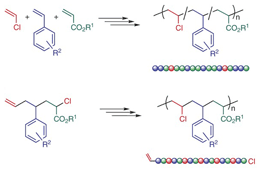Research Abstract
金属触媒を用いた逐次ラジカル重合による配列制御ビニルポリマー
タンパク質や核酸は、配列が制御された高分子であり、完璧に配列した一次構造に由来するさまざまな性質がある。
Sequence-regulated vinyl copolymers by metal-catalysed step-growth radical polymerization
2010年4月12日 Nature Communications 1 : 6 doi: 10.1038/ncomms1004

タンパク質や核酸は、配列が制御された高分子であり、完璧に配列した一次構造に由来するさまざまな性質がある。しかし、合成高分子、特にビニルポリマーの配列制御は実現されておらず、高分子化学における究極の目標の1つである。本論文では、一般的なビニルモノマーの構成要素から作った設計されたモノマーの金属触媒逐次ラジカル重付加を用いて、スチレン、アクリル酸エステル、塩化ビニルのユニットからなる配列制御ビニルポリマーを得る方法を報告する。非共役 C=C結合と反応性の高いC-Cl結合を有する設計されたモノマーを、銅触媒を用いて逐次ラジカル重合することで、完璧な塩化ビニル-スチレン-アクリル酸エステル-アクリル酸エステル配列をもつ、前例のないABCC型の配列制御ポリマーが得られた。この方法によって、配列制御合成ポリマーの研究に新たな道が開かれる可能性がある。
- 名古屋大学大学院工学研究科 化学・生物工学専攻
Proteins and nucleic acids are sequence-regulated macromolecules with various properties originating from their perfectly sequenced primary structures. However, the sequence regulation of synthetic polymers, particularly vinyl polymers, has not been achieved and is one of the ultimate goals in polymer chemistry. In this study, we report a strategy to obtain sequence-regulated vinyl copolymers consisting of styrene, acrylate and vinyl chloride units using metal-catalysed step-growth radical polyaddition of designed monomers prepared from common vinyl monomer building blocks. Unprecedented ABCC-sequence-regulated copolymers with perfect vinyl chloride–styrene–acrylate–acrylate sequences were obtained by copper-catalysed step-growth radical polymerization of designed monomers possessing unconjugated C = C and reactive C–Cl bonds. This strategy may open a new route in the study of sequence-regulated synthetic polymers.

